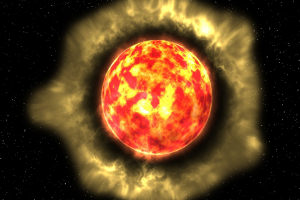University astronomers discover sandstorms in space
12 Apr 2012
Astronomers at The University of Manchester believe they have found the answer to the mystery of a powerful ‘superwind’ which causes the death of stars.

Writing in Nature, the team of researchers used new techniques which allowed them to look into the atmospheres of distant, dying stars.
The team, lead by Barnaby Norris from the University of Sydney in Australia, includes scientists from the Universities of Manchester, Paris-Diderot, Oxford and Macquarie University, New South Wales. They used the Very Large Telescope in Chile, operated by the European Southern Observatory.
At the resolution used by the scientists, one could, from the UK, distinguish the two headlights on a car in Australia. This extreme resolution made it possible to resolve the red giant stars, and to see winds of gas and dust coming off the star.
Stars like the Sun end their lives with a ‘superwind’, 100 million times stronger than the solar wind. This wind occurs over a period of 10,000 years, and removes as much as half the mass of the star. At the end, only a dying and fading remnant of the star will be left. The Sun will begin to throw out these gases in around five billion years.
The cause of this superwind has remained a mystery. Scientists have assumed that they are driven by minute dust grains, which form in the atmosphere of the star and absorb its light. The star light pushes the dust grains (silicates) away from the star.
However, models have shown that this mechanism does not work well. The dust grains become too hot, and evaporate before they can be pushed out.
The scientists have now discovered that the grains grow to much larger sizes than had previously been thought. The team found sizes of almost a micrometer – as small as dust, but huge for stellar winds.
Grains of this size behave like mirrors, and reflect starlight, rather than absorbing it. This leaves the grains cool, and the star light can push them out without destroying them. This may be the solution to the mystery of the superwind.
The large grains are driven out by the star light at speeds of 10 kilometres per second, or 20 thousand miles per hour – the speed of a rocket. The effect is similar to a sandstorm. Compared to grains of sands, the silicates in the stellar winds are still tiny.
Professor Albert Zijlstra, from The University of Manchester’s Jodrell Bank Observatory, said the breakthrough changes our view of these superwinds. For the first time, we begin to understand how the superwinds work, and how stars (including, in the distant future, our Sun) die.
He added: “The dust and sand in the superwind will survive the star, and later become part of the clouds in space from which new stars form. The sand grains at that time become the building blocks of planets. Our own Earth has formed from star dust. We are now a big step further in understanding this cycle of life and death.“
